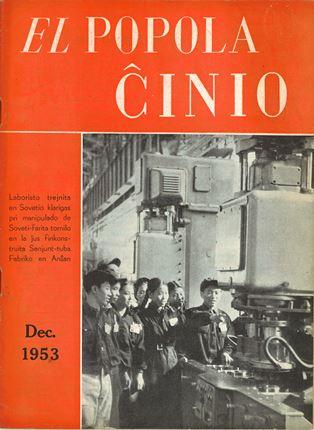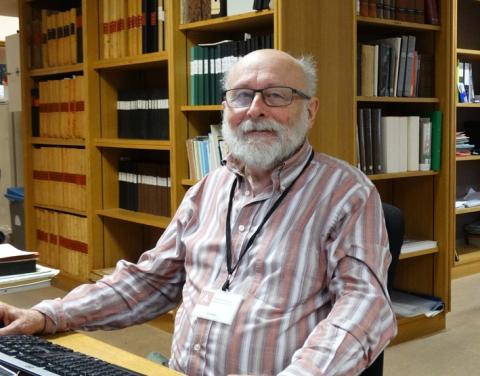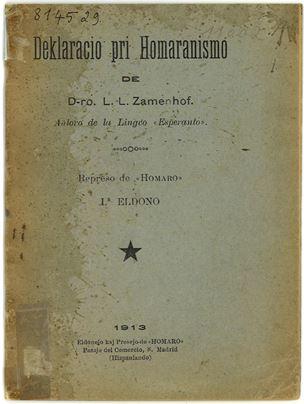Cyreen, can you give us a short introduction to Esperanto?
Esperanto is an artificially created language invented in 1887 by Ludwik Lejzer Zamenhof, a Polish Jew. At that time Poland was part of Russia, and inhabited by Poles, Jews, who were oppressed, Germans and Russians. There was a lot of conflict between all those peoples. Zamenhof thought that by creating a simple common language, a better world could be created. Already in high school Zamenhof tried to design an artificial language.
Zamenhofs linguistic interest wasn’t a surprise. His father was a censor for the repressive Tsarist regime; so reading was his profession. He also had a private school, where he taught German and French. Father Zamenhof also published a collection of mostly Polish proverbs, which his son later translated into Esperanto. However, Zamenhof senior wasn’t too pleased with his sons hobby, ordering him to stop designing artificial languages, even destroying all his notebooks at one point. Zamenhof was then told to study medicine. Only after he had become an ophthalmologist could Zamenhof continue with his project.
At first he considered Latin or Greek as a universal language, but he thought them too difficult. He was looking for a neutral language that wasn't bound to any nation. There already existed a predecessor, Volapük, invented around 1880 by Johann Martin Schleyer. That language was based on simplified English, but turned out to be difficult to learn. Zamenhof based 70% of his Esperanto on Romance languages, making it – at least for Europeans – fairly easy to remember.
‘Esperanto’ means "He who hopes"; originally it was a pseudonym of Zamenhofs, referring to his hope for a better world; in fact it is part of the broader movement that Zamenhof was aiming for, which was not focused only on language. Zamenhof had a project he called Homaranismo, a kind of humanism, which aimed at uniting all the world’s religions. Other Esperantists were not so keen in this idea, fearing that the religious aspect would reflect badly on the language movement. There are still some religious groups with similar ideas, like the Bahá’í and the Oomoto in Japan. From its inception at the beginning of the twentieth century, Esperanto has played an important role in Oomoto, and has been recognized as the language that humanity should speak.
- Esperanto is a constructed language, but also a living language. Is there some sort of oversight, validating new words for example?
There is even an Academy of Esperanto, which checks whether new language elements match the original grammar. The Academy publishes lists of new words that have been accepted. The basis is a "fundamenta gramatiko", a basic grammar of 16 rules. There is also a 'fundamenta vortaro', the original dictionary compiled by Zamenhof. Both fundamental publications are still recognised.
Zamenhof also wrote a "fundamenta krestomatio", an anthology of texts that meet Esperanto standards. There is disagreement among Esperantists about how the language should evolve. Some, like me, think that you should adhere strictly to the rules; others disagree and are more permissive. For example, a very good writer, the German Richard Schultz, strictly followed Zamenhof’s rules and writing style, but he was denounced by the Esperanto establishment.
- Has Esperanto always been a minority language, or were there times when it was more popular?
The heyday was before the Second World War, when the League of Nations in Geneva even considered making Esperanto the official (second) language. But France was very much opposed. That was rather shortsighted of them, now they are outclassed by English. In the 1920’s and 1930’s Esperanto lived strongly among the working classes, because they saw a connection between the bad position of the world's labour force and the knowledge of different languages. In 1921 an association was founded to defend the interests of the workers and Esperanto, the Sennacieca Asocio Tutmonda (SAT), which still exists today.
The rise of Nazism brought a major setback for Esperanto. Not only because it was invented by a Jew, but also because it was international and dictators like Hitler or Stalin were concerned about communication across national borders. They had Esperantists persecuted; several were executed under Stalin. In 1988, Ulrich Lins published a book about this, La danghera lingvo (translated as Dangerous Language. Esperanto under Hitler and Stalin), which has been translated into nine languages. The Esperanto version is also available in the Hendrik Conscience Library. After the Second World War there was a short revival, but in general the interest in Esperanto has stagnated.
There is little promotion of the language, neither by governments, nor in education. Many educators think Esperanto is irrelevant, or perhaps even worse: they fear that once people know Esperanto they will learn fewer other languages. Someone who has a position because of his linguistic knowledge may feel threatened. I disagree, of course. In my case I have a general interest in languages, including Esperanto but not excluding others.
Nowadays, if you know some English, French, German and Spanish, you can get very far already; but it won’t help you in a place like China or Japan. It would make more sense for everyone to learn Esperanto as a second language, because then you can communicate with the whole world. Unfortunately the world doesn’t work like that. There are all kinds of psychological factors and interests that prevent the most logical solution.
- To what extent do new books or magazines still appear in Esperanto?
It is impossible to compare the number of books in Esperanto to those in the great culture languages. According to the ‘laste aperis’ section in the monthly international journal Esperanto about 150 works appeared in 2019, with 49% original works, 44% translations and 7% other works. The last number refers to works published on Esperanto in other languages. It is assumed that since 1887, about 10,000 in Esperanto were published.
As the Concise encyclopedia of the original literature of Esperanto by G. Sutton shows, creative writing is well practiced by Esperantists. A lot is also published in the large number of local journals in Esperanto. A dozen of magazines are read worldwide, such as Esperanto,Heroldo de Esperanto,Sennaciulo, La Ondo de Esperanto, and our Antwerp Monato. The Antwerp association, moreover, is one of the major publishers of books in Esperanto.

There are some decent original authors with a good style, who have further developed Esperanto. In the beginning the vocabulary was rather limited, but in Esperanto you can always create new words. It is a language with which you can easily compose combinations. Some good writers are the Hungarians Julio Baghy and Kálmán Kalocsay, the Frenchman Gaston Waringhien, and the Swiss Edmond Privat, but there are no writers of the level of Shakespeare, Hemingway, Zola, Garcia Lorca, … yet!
- How did you first learn about Esperanto?

I happened to come into contact with it when I was about 22. I lived in a small village, Westkerke (West Flanders). I had seen an article in a local newspaper about an Esperanto conference in England, in Stoke-on-Trent. I couldn't find any information in the parish library, so I contacted the Esperanto society in Stoke-on-Trent. They referred me to the contact point in Bruges. There I bought a textbook for 100 francs, which was quite expensive in those days. There was also a free magazine in Esperanto from China, El popola Ĉinio. It contained communist propaganda and beautiful pictures. It was available from the Chinese embassy in the 1970s – the heyday of communism. The Heritage Library also has some copies of it. It still exists, but it is published in digital form only.
Around that time I graduated as an agricultural engineer from Ghent University. I was more interested in literature, languages and history, but I decided to study agricultural engineering to avoid conscription. As an agricultural engineer I was able to go abroad, and I spent 14 years in Rabat, Morocco, doing forestry research. I had a good time there, but I had no personal contacts with Esperantists. All I had was a subscription to Heroldo de Esperanto, a popular Esperanto magazine.
- So you learned Esperanto by yourself with only the textbook and magazines?
Yes, just by practicing it by myself. It wasn’t very intensive, but from time to time I would buy a book in Esperanto, during the holidays for example. You have to realize that publications in Esperanto are only available through a separate circuit of Esperanto associations, you can’t buy them in a regular bookstore.
- If I understand correctly, for you Esperanto is something that starts from your personal interest in languages. It's not a social thing?
No, the social aspect isn't that important to me. But you have to maintain Esperanto a bit, otherwise you'll forget it.
About 1983, when I was still living in Morocco, I came into contact with Hermann Simon, who was living in the GDR. He was working on a dictionary about forestry and was looking for collaborators who were fluent in different languages, including Dutch. I was a forester and I knew Esperanto. My contribution to Lexicon Silvestre was my first and only one to Esperanto at the time.
It wasn't until I retired eight years ago that I found time to take it up again. I am the secretary of the Esperanto Association in the village of Kalmthout and its surroundings. But it’s only a small group of people, 12 members, and effectively about 5 people who meet monthly. Antwerp houses the largest Esperanto association in Flanders, which has 100 members.
I also volunteerd for the job of librarian at the Esperanto Library in Antwerp, from 2012 to 2019. When the library was to be moved to the basement of a building at the Sint-Jacobsmarkt, I didn't feel like that was a good location for a library and proposed to transfer the collection to the Hendrik Conscience Heritage Library. My proposal initially met with resistance, but in the end everbody in the association realised that the storage conditions, the online catalogue and the access to the collection in the Heritage Library were much better.
- In the Hendrik Conscience Library, the Esperanto collection still has a future…
Absolutely. The most important works and the most prominent authors in Esperanto are represented, even now when cataloguing isn’t completed yet. The Hendrik Conscience Library now houses about 4,000 works, while in total there are only about 10,000 titles in Esperanto worldwide.
Moreover, the collection will probably be expanded soon with a large part of the Esperanto Library from Kortrijk, which has an international reputation. It was donated to the public library of Kortrijk in the 1970s by the Esperanto collector Vanbiervliet. But a public library is not a depository library and there is no room for the collection in Kortrijk's new library building. If it is transferred to Antwerp, this will make the Hendrik Conscience Heritage Library one of the largest and most complete public Esperanto collections in Belgium and the Netherlands.
I think it’s important that such a collection is kept in an heritage library. Esperanto should be studied more by scientists, not just by hobby Esperantists. Now that all these books in Esperanto are included in the collection of the Hendrik Conscience Heritage Library, they can be consulted by everyone. Moreover, the library’s catalogue is incorporated into WorldCat, which has an international reach. So potentially the whole world can discover that a title is availalable in the Hendrik Conscience Heritage Library.
- Let’s talk about your work here as a volunteer. What does it consist of?
I am the cataloguer of the Esperanto collection. It’s an interesting and challenging task. As a cataloguer you have to grasp the content of the book in a very short time. When I was the librarian of the Flandra Esperanto-Ligo, before the collection came to the Hendrik Conscience Heritage Library, I already had most of the books in my hands. The previous cataloguer had only done half of the work, I finished it. I thought I was an experienced cataloguer, but of course that was only a basic description in an Excel file. When I came to the Conscience Library, it turned out to be very different. The software is quite complex. Fortunately I was able to learn it quickly. I love doing it. It's so easy to search and click through on subjects and other terms. The Hendrik Conscience Heritage Library catalogue is the best in the world!




